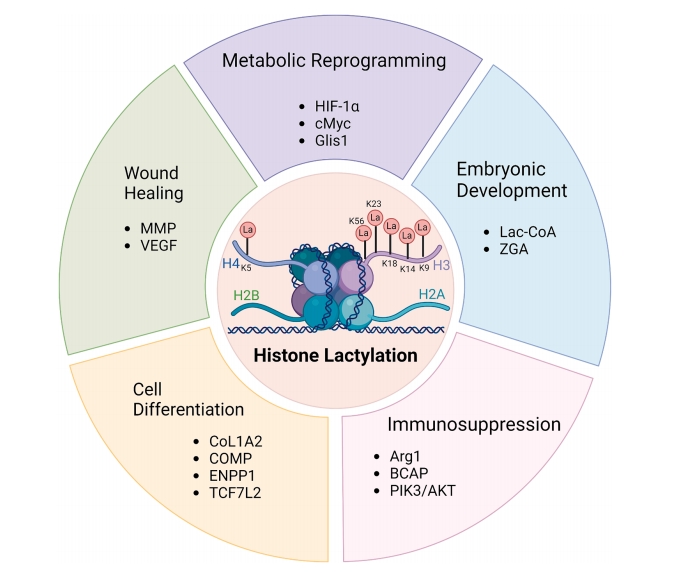Histone Lactylation Analysis Service
Based on an advanced LC-MS/MS platform and efficient modified peptide enrichment methods, the histone lactylation analysis service launched by MtoZ Biolabs enables systematic identification and quantification of histone lactylation modifications. This service can identify lactylation modifications at different sites and analyze their abundance changes under different conditions. By integrating bioinformatics methods, it provides high-quality data including modification site distribution, differential comparison, and functional annotation, offering strong data support for studying the role of lactylation in cellular regulation and metabolic networks.
Overview
Histone lactylation (Kla) refers to a novel post-translational modification in which a lactyl group is attached to lysine residues of histones, closely associated with cellular metabolite lactate levels. This modification plays an important role in chromatin structure regulation and transcriptional activity maintenance and is closely linked to biological processes such as immune responses, metabolic reprogramming, and tumor microenvironment adaptation. Histone lactylation analysis can achieve precise qualitative and quantitative characterization of Kla modifications by combining high-resolution mass spectrometry with specific enrichment strategies. It is widely applied in epigenetics research, metabolic regulation mechanism exploration, and potential biomarker discovery, providing reliable data support for a deeper understanding of the role of lactylation in cellular functions and pathological processes.

Xu, K W. et al. Biochemical Pharmacology, 2024.
Figure 1. Key Functions of Histone Kla.
Analysis Workflow
1. Histone Extraction and Digestion
Histones are isolated from cell or tissue samples and enzymatically digested under optimized conditions to generate detectable peptides.
2. Modified Peptide Enrichment
Specific enrichment strategies are applied to effectively capture lactylated peptides, improving detection sensitivity.
3. LC-MS/MS Analysis
High-resolution mass spectrometry is used for precise identification and quantification of lactylation modification sites.
4. Data Analysis
Bioinformatics methods are integrated to provide results including modification distribution, abundance differences, and functional annotation.
Sample Submission Suggestions
1. Sample Type and Quantity

Note: Plasma should be collected using EDTA as an anticoagulant. Standard tissue or cell lysis buffers can be used during protein extraction.
2. Sample Transportation
Avoid repeated freeze-thaw cycles. Samples are recommended to be stored at -80°C and transported on dry ice to ensure low-temperature conditions throughout the process and prevent modification loss.
Note: For special samples or if a detailed submission plan is required, please contact MtoZ Biolabs technical staff in advance.
Service Advantages
1. High-Resolution Platform
Relying on advanced mass spectrometry systems to ensure precision in site identification and data depth.
2. Optimized Enrichment Strategy
Utilizing efficient enrichment methods for modified peptides to significantly improve identification coverage.
3. Reliable Quantitative Analysis
Standardized workflows enable comparability and reproducibility of lactylation levels under different conditions.
4. Flexible Experimental Design
Experimental workflows can be customized according to research objectives and sample characteristics to meet diverse needs.
Applications
1. Metabolic Regulation Research
By detecting lactylation modification levels, study their relationship with energy metabolism and lactate accumulation.
2. Epigenetics Research
Histone lactylation analysis service can be used to elucidate the role of lactylation in chromatin structure changes and transcriptional regulation.
3. Potential Biomarker Discovery
By identifying lactylation features under different physiological or pathological conditions, this supports the discovery of novel biomarkers.
4. Cellular Function Research
Histone lactylation analysis service can be used to investigate the dynamic regulation of lactylation in cell differentiation, immune responses, and stress adaptation.
FAQ
Q1: Which Modification Sites Can Histone Lactylation Analysis Detect?
A1: It primarily targets lactylation modification sites on histone lysine residues, such as specific sites on H3 and H4, and can also be expanded to other sites according to research needs.
Q2: Does This Service Support Integration with Transcriptomics or Metabolomics?
A2: Yes. Since lactylation is closely associated with lactate metabolism and gene expression, combining it with transcriptomics and metabolomics enables multi-omics integration to obtain a more comprehensive regulatory network.







